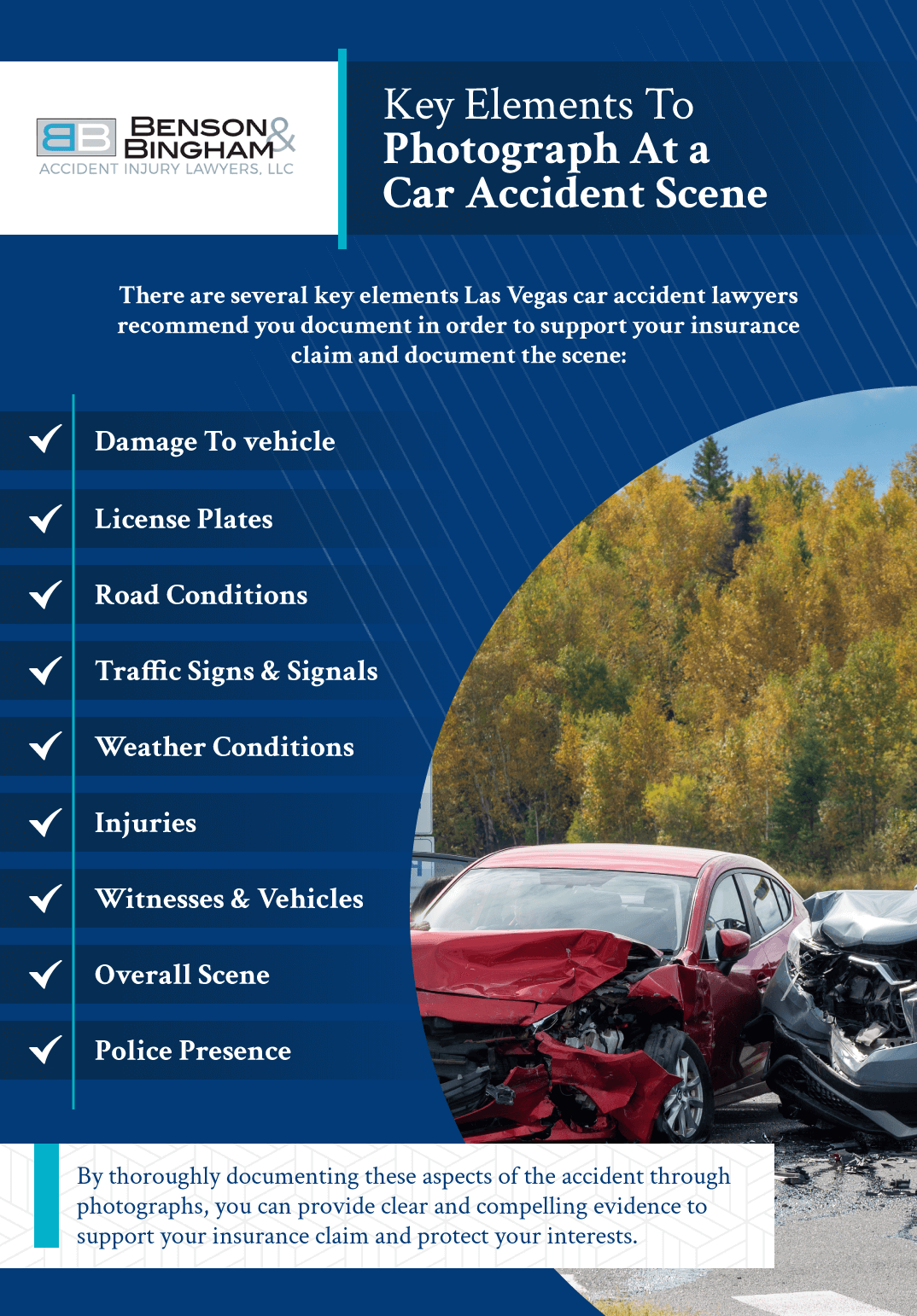What’s the Process For Photographing & Documenting Evidence In Car Accident Lawsuits
With the advent of the smartphone, taking photos is quick and easy. People have their phones out to take photos of everyday life to share with their friends and social media. After a car accident is an especially important time to use your camera! Photos of all aspects of the car accident can prove invaluable when determining what happened and how insurance plays a role.
As time goes on, your memories can get hazy as to what happened. You can have two people remembering two different things and being confident that their story is what happened; this may lead to disputed liability. Pictures can mitigate this problem. Las Vegas car accident lawyers have a few tips on taking pictures after an accident that can enhance your case and potentially maximize your compensation.
Do You Need A Professional Camera To Take A Photo Of The Accident?

When you take the photo, remember the goal is not to get a perfect picture, but rather a comprehensive picture. You could also store a disposable camera in your glove box in the event of a car accident to ensure the invaluable evidence.
Best Practices For Taking Effective Photos Of Your Accident
What is more important than your camera’s quality is the way you take the picture. For the best results, do your best to avoid blurry photos by ensuring stabilization. Pay attention to the lighting conditions and try to take photos during the daylight hours or in well-lit areas to capture the details.
Take multiple photos from different angles to thoroughly document the damage to your vehicle and surrounding scene. Additionally, consider taking wide-angle shots to provide context and take close-up shots to highlight specific damage. Finally, make sure the camera’s date and time settings are accurate to establish when the photos were taken.
Key Elements To Photograph At a Car Accident Scene
There are several key elements Las Vegas car accident lawyers recommend you document in order to support your insurance claim and document the scene:
- Damage To Vehicle: Capture clear photos of the damage to all vehicles involved in the accident from multiple angles. Focus on areas of impact, dents, scratches, and any other visible damage.
- License Plates: Take close-up photos of the license plates of all vehicles involved in the accident to accurately identify them.
- Road Conditions: Document the condition of the road where the accident occurred, including any hazards, debris, skid marks, or road signs that may have contributed to the accident.
- Traffic Signs & Signals: Photograph nearby traffic signs, signals, and intersections to provide context for the accident and clarify who had the right of way.
- Weather Conditions: If relevant, capture images of the weather conditions at the time of the accident, such as rain, snow, fog, or sun glare, as this information may be important for determining liability.
- Injuries: If you or any passengers sustained visible injuries, take photos to document the extent of the injuries, such as bruises, cuts, or abrasions.
- Witnesses & Vehicles: If there are any witnesses to the accident, photograph their vehicles and obtain their contact information if possible, as their testimony may be valuable for your insurance claim.
- Overall Scene: Take wide-angle shots to capture the overall scene of the accident, including the positions of vehicles, any relevant landmarks, and the surrounding area.
- Police Presence: If law enforcement officers are present at the scene, photograph their vehicles and obtain the officer’s name and badge number for reference.
By thoroughly documenting these aspects of the accident through photographs, you can provide clear and compelling evidence to support your insurance claim and protect your interests.

Identifying Additional Photographic Evidence After a Car Accident

If you are unable to find any other individuals taking photos aside from yourself, consider looking around for surveillance cameras from a nearby business that could have recorded your accident. These will most likely be in busier areas, but some intersections have them as well.
Once you have located all of the photograph evidence of your accident, give them to your lawyer who will be able to use them to create a stronger case in your favor.
Get Expert Legal Support From Our Experienced Las Vegas Car Accident Attorneys
Benson & Bingham Accident Lawyers is here to provide expert legal assistance and guidance when you need it most. With years of experience handling car accident cases in Nevada, we have the knowledge and skills to navigate the complexities of the legal system on your behalf. Whether you’ve been injured in a collision or need assistance with an insurance claim, Our Las Vegas Personal Injury Lawyers will fight tirelessly to protect your rights and secure the compensation you deserve.
Don’t face the aftermath of a car accident alone, contact us to get the justice and compensation you’re entitled to.
Read About Our Other Secret Top Tips to Maximize Your Compensation
1. Settle Faster, Settle Bigger: 20 Tips From Top Injury Lawyers for Maximizing Your Settlement
2. Understanding the Insurance Process: Navigating insurance claims and negotiations effectively.
3. Gathering Crucial Evidence: Tips for collecting and preserving evidence to strengthen your case.
4. Documenting Your Injuries: Importance of thorough medical documentation for maximizing compensation.
5. Negotiating with Insurance Adjusters: Techniques for achieving a favorable settlement offer.
6. Understanding Settlement Offers: Evaluating offers and knowing when to accept or negotiate further.
7. Considering Future Damages: Anticipating long-term medical expenses and future losses.
8. Avoiding Common Mistakes: Pitfalls to avoid that could jeopardize your settlement.
9. Calculating Your Damages: Including medical bills, lost wages, and non-economic damages.
10. Proving Liability: Strategies for establishing fault and holding the responsible party accountable.
11. Dealing with Medical Providers: Managing medical bills and liens during the settlement process.
12. Utilizing Expert Testimony: Leveraging expert witnesses to support your claim.
13.Navigating Legal Deadlines: Understanding statutes of limitations and other time constraints.
14. Preparing for Litigation: Steps to take if settlement negotiations break down and litigation becomes necessary.
15. Seeking Emotional Support: Importance of seeking emotional support during the settlement process.
16. Reviewing Legal Fees and Costs: Understanding the financial aspects of hiring a lawyer and pursuing a claim.
17. Handling Subrogation Claims: Dealing with reimbursement claims from insurance providers.
18. Staying Informed and Empowered: Keeping up-to-date with the progress of your case and asking questions.
19. Protecting Your Rights: Knowing your legal rights and advocating for fair treatment throughout the process.
20. Maintaining Confidentiality in Settlement Negotiations and Mediations


